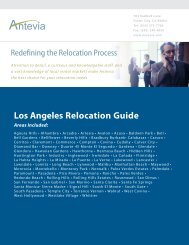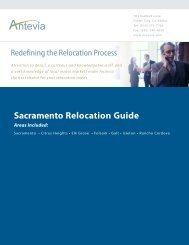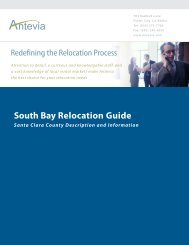San Francisco Relocation Guide - Antevia
San Francisco Relocation Guide - Antevia
San Francisco Relocation Guide - Antevia
Create successful ePaper yourself
Turn your PDF publications into a flip-book with our unique Google optimized e-Paper software.
Like many other <strong>San</strong> <strong>Francisco</strong> neighborhoods, Noe Valley started out as a working-class<br />
neighborhood for employees in <strong>San</strong> <strong>Francisco</strong>'s once-thriving blue-collar economy, and<br />
their families. Also like other <strong>San</strong> <strong>Francisco</strong> neighborhoods, Noe Valley has since<br />
undergone successive waves of gentrification and is now considered an upscale, yuppie<br />
area. It is home to many urban professionals, particularly young couples with young<br />
children, and it is not unusual for a well-maintained house in Noe Valley to sell for a<br />
million dollars or more.<br />
Public transportation to Noe Valley is provided by the Muni 24, 35, and 48 bus lines, and<br />
by the J Church Muni Metro line.<br />
History<br />
The Neighborhood is named after Jose de Jesus Noe, the last Mexican alcalde (or mayor)<br />
of Yerba Buena (present day <strong>San</strong> <strong>Francisco</strong>).<br />
Noe Valley was primarily built up at the end of the 19th century and at the beginning of<br />
the 20th century, especially in the years just after the 1906 <strong>San</strong> <strong>Francisco</strong> Earthquake. As<br />
a result, the neighborhood contains many examples of the "classic" Victorian and<br />
Edwardian residential architecture for which <strong>San</strong> <strong>Francisco</strong> is famous. Noe Valley being<br />
a working-class neighborhood, houses were built in rows, with some of the efficient, lowcost<br />
row houses being more ornate than others, depending on the owner's taste and<br />
finances. Today, Noe Valley has the highest concentration of row houses in <strong>San</strong><br />
<strong>Francisco</strong>, with streets having three to four and sometimes as many as a dozen on the<br />
same side of the same street. Few rows remain untouched.<br />
Many Noe Valley streets were laid out and named by John Meirs Horner, who named<br />
Elizabeth Street after his wife and Jersey Street after the state where he was born. Most of<br />
Noe Valley is still called Horner's Addition for tax purposes by the city assessor's office.<br />
Geography<br />
The topographic layout is actually two main valleys. One flows from the<br />
Clipper/22nd/Grandview area down 24th/Jersey to Church, and the other flows from the<br />
27th/Diamond/30th area down Day to Church where it meets the first valley; the<br />
conjoined valleys then both exit the Noe Valley district. This makes the hilly area<br />
relatively dry, and the soil stable regarding earthquake liquefaction. Most houses up the<br />
hills sit directly on bed rock as can be seen at Douglass Park (bare red rock). Traffic flow<br />
is limited - one main North access through Castro Street to Eureka Valley, one main West<br />
access up Clipper Street toward the former Twin Peaks toll plaza and West of the city,<br />
several East access to Mission through 24th, Cesar Chavez and other numbered streets,<br />
and the main North-South Church access used by the Muni Light Rail J-Church. There<br />
are no traffic lights except along Dolores Street, at the 24th/Castro intersection, and one<br />
at 23rd and Church.







